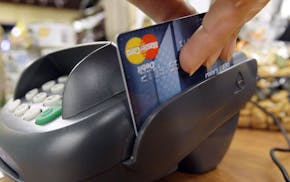Greedy. Craven. Immoral.
Those are a few of the kinder insults that have been lobbed at Wal-Mart, Target, Best Buy and other merchants that have chosen to open their stores at midnight or earlier on Thanksgiving Day.
I'd like to offer a different motive to explain that decision: desperation. The kind that comes when your stock price is treading water, sales and profit are flat, and some of those big boxes seem awfully empty.
Or the kind you feel when you learn that last Thanksgiving, while your stores were closed and your employees were enjoying dinner with their families, online merchants rang up $400 million in business, with most of those transactions happening in the evening.
The last four years have been tough on most merchants. Retail spending, after adjusting for inflation and excluding gasoline and automobiles, remains below pre-recession levels. While the jury may still be out on whether consumers have embraced frugality or simply resigned themselves to it, the verdict is in on where they like to spend what money they have.
Online retail sales (excluding travel, autos and auctions) has been growing at twice the rate of overall retail spending, according to the research firm ComScore. Online retail sales are expected to climb 13 percent in 2011.
Overall holiday retail sales are expected to rise less than 3 percent this year, but ComScore expects much bigger gains online during the critical months of November and December: Up 17 percent from a year ago, when they totaled $33 billion.
The shift from bricks and mortar to online stores "appears to be accelerating," said ComScore's executive chairman, Gian Fulgoni.
It can be seen most graphically in the growth of Amazon. Despite a weak job market and depressed home prices, sales at Amazon have surged 117 percent during the last four years. During the same period, the combined sales at Target and Wal-Mart are up 18.3 percent, and much of that gain has come through the expensive addition of new stores.
The big retailers operate their own Web stores, of course, and their sales numbers are reflected in the ComScore data. But none of those Web stores has gotten to the point where it represents a critical share of total sales. The most popular, Wal-Mart's, gets about one-third the traffic of Amazon's.
Things are only getting tougher for brick-and-mortar merchants. Traffic to flash sale sites like Zulily and Woot is up 1,000 percent in the last year. And consumers are increasingly using physical stores as showrooms. They come to look at a product, then use their smartphone to shop for a better deal online.
"Retailers are competing with the Internet in their own stores," Fulgoni said Tuesday. "In some ways, it's their worst nightmare."
Black Friday is no longer the busiest day of the holiday shopping season, but its event-like trappings -- 3 a.m. openings, time-limited sales available only in stores -- are vitally important in bringing people to the store and creating momentum for the rest of the season.
"Word of mouth is still so important in setting the tone for the holiday season," said Marshal Cohen, chief retail industry analyst at the NPD Group. "Retailers can't afford to let online merchants beat them to certain opportunities, particularly in the holiday dash."
Cohen expects the backlash over the Thanksgiving Day openings to be short-lived. More stores will open next year, he predicts. And if the sanctity of Thanksgiving has been breached, Christmas Day openings may not be that far away.
"It really is about retailers competing in the 21st century," Cohen said. "They have to be as convenient as any of their competitors."
ericw@startribune.com • 612-673-1736

Wieffering: Time to get over debit card fees
For Thrivent and others, warnings were there

With billions in sales, some co-ops are big business
